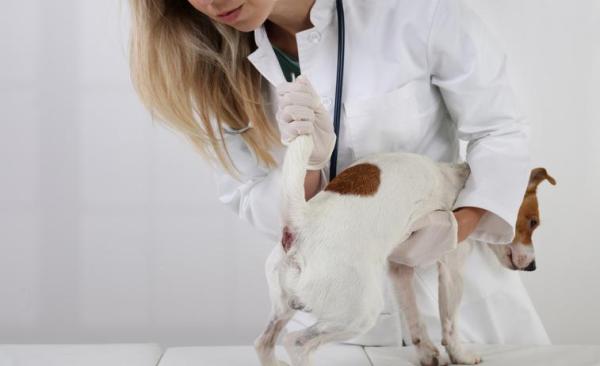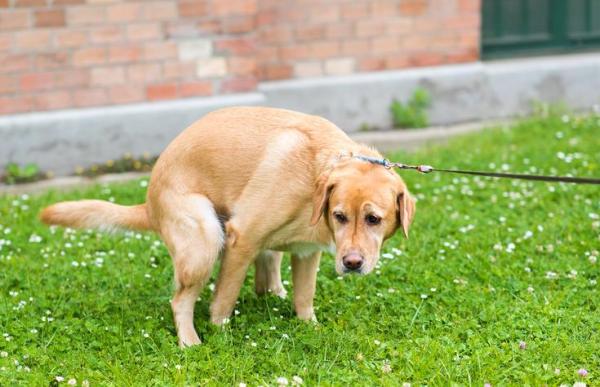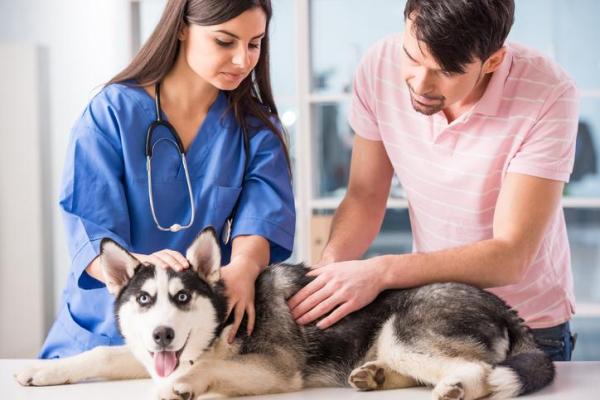Dog hemorrhoids - Symptoms, Causes and Treatment



See files for Dogs
If you observe that your dog’s anus is reddened or inflamed, one would initially assume that this would be a sign of a dog hemorrhoid. However, other than in exceptional cases, dogs do not actually suffer from hemorrhoids. But then, if my dog’s anus is inflamed and/or swollen and it’s not as a result of hemorrhoids, what could it be?
For more, keep reading this AnimalWised article where we discuss which disorders are often confused for hemorrhoids in dogs. In addition, we’ll be discovering how to differentiate, avoid and how to treat dog hemorrhoids. If you notice that your dog’s anus is inflamed, reddened or causing significant pain, we recommend going to a veterinarian as soon as possible in order to diagnose this accordingly. Keep reading here and discover everything you need to know about dog hemorrhoid symptoms, causes and treatment.
Do dogs get hemorrhoids?
So, you may be wondering, can dogs get hemorrhoids? Well not quite, no. In general, one would not refer to this type of inflammation as dog hemorrhoids. Hemorrhoids in humans, also known as "piles", are veins that swell in the rectum or anus. Visually, they look like varicose veins. These hemorrhoids are caused by excessive efforts in defecating or increased pressure during pregnancy.
A dog’s body, however, is completely different from a human’s. The main difference being that a dog’s disposition is horizontal, while ours is vertical. Therefore, because of this difference in body structure, dogs do not actually suffer from hemorrhoids.
The only case in which one could diagnose piles in dogs, would be due to certain tumors. These tumors can grow into the anorectal area and modify, increase pressure, inflame and cause a prolapse in the entire anal area. These tumor types generally appear next to the anus and are more likely to cause hemorrhoids if left untreated. They may also occur in the case of severe constipation or due to the presence of parasites. For more, we recommend reading our article where we discuss all you need to know about a dog’s anal glands.

Hemorrhoids in dogs
So, if dog hemorrhoids are so uncommon, what is my dog actually suffering from? If your dog is showing symptoms of:
- Anal inflammation.
- Redness in the anus.
- Anal discomfort.
- Difficulty or effort defecating.
It’s normal to first assume that these are dog hemorrhoid symptoms. However, these are in fact signs of anal gland problems in dogs or rectal prolapse.
In addition, if you observe any anal problems in puppies, such as increased itchiness and irritation, the most common cause of this are intestinal parasites in dogs. These worms, if found in high amounts, can also cause diarrhea in puppies. You may also notice an increase in defecation frequency, puppy scooting (dog dragging bum), or licking of the anus.
In the case of puppy parasites, it’s incredibly important that you follow your dog’s deworming schedule strictly. Whenever you adopt a dog or puppy, we recommend going to a veterinarian immediately to set up an appropriate antiparasitic and deworming schedule. In addition, if you notice any of the above symptoms in your dog or puppy, we recommend consulting a veterinarian as soon as possible. For more, take a look at our article where we look at, ‘‘Why does my dog drag his bum on the ground?’’
Dog hemorrhoids: symptoms
Dog anal glands are small sacs that are located on both sides of the anus. The function of these glands are to produce liquid to helps lubricate the feces and offer a dog its individual smell. Occasionally, this secretion may appear very dense or a dog’s feces may not compress the glands adequately to release enough fluid. Any alteration which influences this gland production and the release of this liquid can give rise to anal problems in dogs which are easily confused with hemorrhoids. Anal gland problems in dogs which are often confused with hemorrhoids include:
- Fecal impaction in dogs: is when the liquid cannot leave the anal glands correctly and they become full, often caused by a hard mass stool. In this case, a veterinarian may need to empty your dog’s colon manually. Additional treatment requires a high fiber diet to soften a dog’s stools. Is your dog constipated? Take a look at our soft diet for constipated dogs.
- Infection or anal sacculitis in dogs: anal gland impaction can worsen due to an infection or gastrointestinal disease, which can result in a painful inflammation of a dog’s anus. In this case, in addition to manual bowel emptying by a professional, topical antibiotic and disinfection will be required.
- Anal abscess in dogs: refers to an infection which causes fever and red/purple anal inflammation. This accumulation of pus, if it opens externally, can form anal fistulas in dogs. Anal fistula in dogs results in an unpleasant smelling discharge and requires surgery. When it comes to anal abscesses in dogs, emptying the glands alone will not solve this problem. Dog abscesses that remain closed must be opened, cleaned and disinfected correctly. In addition, oral antibiotics are often prescribed. If your dog repeatedly suffers from anal abscesses, anal gland removal is recommended. For more, we recommend reading our article where we discuss everything you need to know about dog abscesses, including their causes, symptoms and treatment.

Dog hemorrhoids: rectal prolapse in dogs
Rectal prolapse in dogs results in a reddened or pink mass coming out of the anus and is easily confused for hemorrhoids in dogs. Rectal prolapse in dogs refers to a fragment of rectum that protrudes through the anus and occurs due to overexertion at the time of defecation, constipation of gravity or on the contrary, diarrhea, obstructions in the anal area, etc.
Although there are degrees of severity when it comes to rectal prolapse in dogs, it is considered a medical emergency because this exposed tissue runs the risk of becoming necrotic. The prolapse will need be be removed surgically and may require bowel repairment.
In mild cases, a veterinarian will need to diagnose the cause in order to treat it correctly. Meanwhile, we recommend offering your dog a soft diet for constipation to soften stools. For more, read about why is my dog bleeding from its anus and its most common causes.
Dog hemorrhoid: treatment
Any case of prolapse or dog anal infections, which may be confused with piles, requires immediate veterinary treatment. If however, for whatever reason you cannot go to a veterinarian immediately, we recommend applying hemonal ointment for dogs onto this sensitive area.
Any other ointments for ‘‘hemorrhoids’’ should be prescribed by a veterinarian only, depending on the correct diagnosis. The reason for this is that if you apply the incorrect ointment, it can worsen the infection or abscess. For example, if there is an infection and you apply an ointment instead of an antibiotic, the cream can pass through the fistula and cause damage.
As prevention, you should always make sure that your dog is fed an adequate high-quality diet with sufficient amounts of water. In addition, make sure you follow your dog’s deworming schedule strictly.

This article is purely informative. AnimalWised does not have the authority to prescribe any veterinary treatment or create a diagnosis. We invite you to take your pet to the veterinarian if they are suffering from any condition or pain.
If you want to read similar articles to Dog hemorrhoids - Symptoms, Causes and Treatment, we recommend you visit our Other health problems category.









